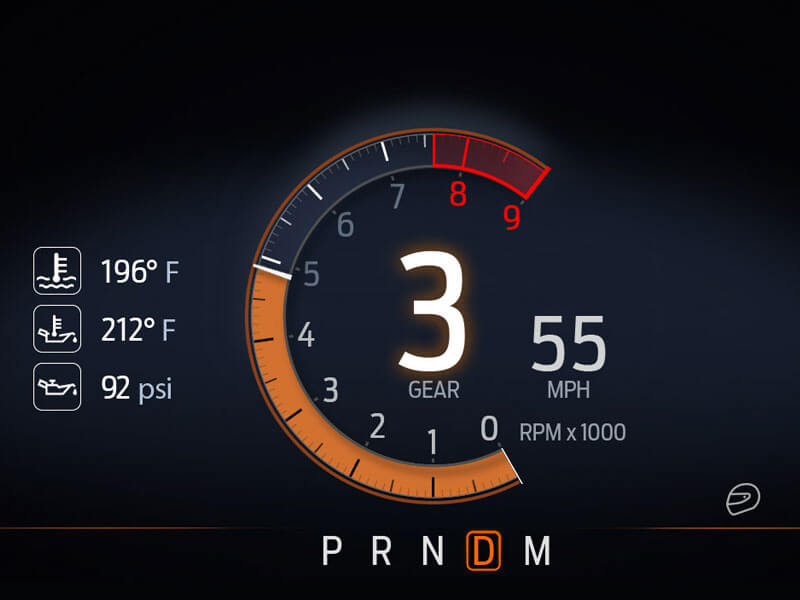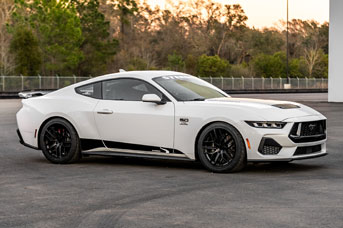Ford Mustang GTD: An Overview

Just when the drool starts to dry up after the introduction of the S650 Mustang, Ford is at it again. The Le Mans debut of the Mustang GTD introduces a new ultra-high-performance variant of the iconic pony car. The limited-production GTD (Grand Touring Daytona) leaves the Mustang GT and Dark Horse in the dust thanks to a supercharged V8 making over 800 horsepower.
The Le Mans rollout of the street-legal GTD is no accident. Sixty years ago, Ford sought to take on Ferrari at the famed circuit. By the late 1960s, the storied GT40 would dominate the podium and rack up three wins that decade. But the Blue Oval had another track in mind with the Mustang GTD launch: Germany’s Nürburgring Nordschleife. The company has been vocal about its goal of lapping the ‘Ring’ in under seven minutes.
Table of Contents
Design and Engineering
From the outset, the Mustang GTD was created to deliver outstanding performance on demanding racing circuits. Mustang GTD chief program engineer Greg Goodall explained the engineering team's strategy, “To meet the aggressive lap time targets we set, we looked to motorsports for inspiration to do something really advanced. This cutting-edge suspension and advanced dampers are key to turning a Mustang into a Mustang GTD.”
The formula also includes active aerodynamics and lightweight materials designed to produce a well-rounded car. Goodall elaborated on this philosophy, "Many sports cars excel at one thing. But for a car to set a quick lap at the Nürburgring, it needs to be great at everything. Cornering, grip, braking, acceleration, there's not a single area where it can't shine."
Powertrain
Ford hasn’t released the final output number for the GTD’s formidable 5.2-liter supercharged V8 engine, but a promise of over 800 horsepower and 625 lb-ft of torque more than whets the appetite. Supporting the powerplant is a 2.65L Eaton TVS R2650 roots-style supercharger. Ford also incorporated a dry-sump oiling system to limit oil starvation during high-G cornering.

An active quad-tip titanium exhaust system minimizes weight while producing a distinctive and aggressive soundtrack. However, engineers didn’t deviate too far from the S650 platform, as the Mustang GTD remains rear-wheel drive. The gearbox is another matter, as Ford gave the GTD a Tremec 8-speed dual-clutch automatic transmission.
High-capacity cooling systems and a reinforced drivetrain underscore the powertrain. There’s also abundant use of 3D printing and other advanced manufacturing techniques to keep weight to a minimum while ensuring durability.
Exterior Design and Aerodynamics
While one glance at the GTD’s exterior reinforces the obvious Mustang connection, Ford introduced aggressive styling that still features functional aerodynamics. At the same time, lightweight carbon fiber is used for the car’s bodywork, contributing to a notable power-to-weight ratio. The lucky few GTD owners can choose from several color options, including Chroma Flame burgundy, which debuted at Le Mans.
For buyers looking for more downforce than what’s generated by the standard bodywork, front splitter, underbody panels, and active rear wing, Ford is offering an optional Performance Package. The upgrade takes the GTD’s aerodynamics to the next level with dive planes, a larger front splitter, underbody flaps, and a rear wing drag reduction system. This active aero system reduces drag on straightaways while reinforcing critical downforce during cornering. According to Ford, a Performance Package-equipped GTD can generate nearly two tons of downforce.
Suspension and Chassis
Ford takes great pride in the Mustang GTD’s advanced suspension system, which features a semi-active setup with Multimatic's Adaptive Spool Valve (ASV) dampers at all four corners. The rear dampers are mounted inboard using a rocker system, allowing minimal pitch and roll during cornering while still providing a compliant ride.

Calling the rear shocks ‘racing jewelry,’ Ford added a unique in-cabin suspension window that takes the place of the rear seat. The polycarbonate panel, which can also be seen through the rear window, showcases the blue and gold damper accents while allowing a peek at how the suspension works in real time.
The ASV dampers can adjust from their softest to firmest settings in 15 milliseconds, enabling rapid adaptation to changing road conditions and driver inputs. To put that response time in perspective, an involuntary eye blink takes 100–150 milliseconds.
The suspension works in tandem with the GTD's electronic control units and drive mode software, which includes Normal, Sport, Drag, Track, and V-Max settings. In Track mode, the suspension lowers by nearly 40mm and firms up, improving the aerodynamics and mechanical grip.
The GTD's chassis is constructed from lightweight aluminum, while the rear subframe is sturdy tubular steel.
Wheels, Tires, and Brakes
The Mustang GTD rides on 20-inch wheels wrapped in Michelin Pilot Sport Cup 2 R tires developed specifically for the car. The standard rims are made from aluminum, but customers can opt for magnesium wheels to further reduce weight.
Brembo carbon-ceramic brakes provide the stopping power. The front setup features massive 17-inch rotors clamped by 6-piston calipers, while the rear brakes rely on 15-inch rotors with 4-piston calipers.
Interior and User Experience
The state-of-the-art cabin from the S650 Mustang makes its way into the GTD but with modifications. Front and center are GTD-emblazoned Recaro front seats, which provide bolster support during high-G maneuvers. The upholstery combines leather and Alcantara suede, while optional carbon fiber seat backs add style and weight reduction.
Alcantara makes its way onto the GTD’s steering wheel for improved grip and tactile feedback. The wheel is also embedded with controls to manage the drive modes and performance settings, allowing drivers to stay focused on the task at hand. Those behind the wheel of the Mustang GTD will further interact with 3D-printed titanium shift paddles and a rotary gear selector.

The Mustang GTD also features the sweeping digital dashboard panel from the S650. Its 12.4-inch digital instrument cluster provides crisp, customizable displays for vehicle information and data logging. The graphics are powered by Unreal Engine, a cutting-edge rendering system that delivers photorealistic images and animations. The center touchscreen incorporates GTD-specific software and graphics, including the Track Apps suite, which offers performance timers and telemetry systems for analyzing race performance.
Pricing and Availability
The Mustang GTD's starting price is $325,000, positioning it as one of the most expensive and exclusive Mustang variants ever produced. Despite the hefty price tag, many enthusiasts are willing to pay a premium for the chance to own a piece of Mustang history.
If you have $325,000 lying around and haven’t already ordered a Mustang GTD, you can leave your money in the bank or crypto account. Ford closed the ordering window on May 21, about a month after announcing availability. The company reports receiving over 7,500 applications. However, Ford anticipates building only 300 to 700 GTDs annually for 2025 and 2026, which will leave many disappointed.
The allocation process has not been revealed yet. However, news reports indicate that Ford will pay dealers a flat $15,000 for each GTD sold to discourage markups.
Ford Mustang GTD Fast Facts
- Price: $325,000 (base)
- Engine: Supercharged 5.2-liter V8
- Engine Output: 800+ horsepower / 625 lb-ft of torque
- Top Speed: 190 MPH (targeted)
- Production: 300–700 units per year (2025–2026)
Media

























